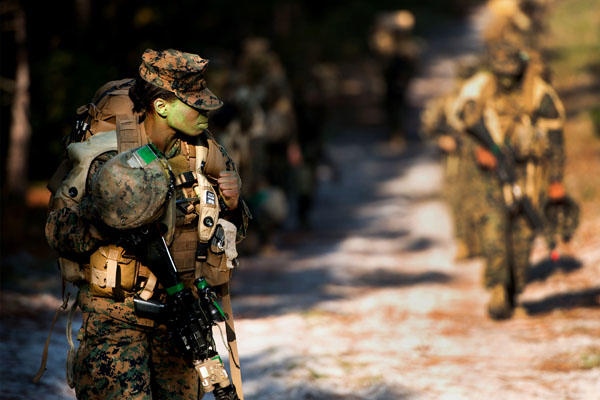Emerging details of the U.S. Marine Corps study on the integration of women into direct-action combat jobs raise questions about the validity of its findings and whether the study was engineered to keep women out of infantry units, critics say.
The effort compared the performance of units with inexperienced female Marines -- fresh out of training -- against units made up of experienced male infantrymen, while focusing on speed and accuracy when engaging targets with multiple weapons systems, according to a Marine source familiar with the effort.
The Marines in these ad hoc units cycled in and out from one task to the next, which made it difficult to develop unit cohesion, the source said.
Women volunteering for the effort were screened at a lower physical-fitness standard than men but were expected to perform at the same strength and endurance levels as males on tasks such as negotiating obstacles and evacuating casualties, the source said.
Once testing was complete, the study showed that all-male units demonstrated higher performance levels than gender-integrated units on 69 percent of tasks evaluated.
The Marine Corps publicly released an executive summary of the study in early September, a move that put Navy Secretary Ray Mabus at odds with the Marine Corps leadership over whether women should serve in direct-action combat jobs such as infantry.
Mabus has weathered considerable criticism for his decision that there will be no exceptions to the Defense Department's policy mandating that all combat-arms jobs be opened to women.
A spokesman for his office didn't provide a response to a request for comment. But Mabus may find more support for his position.
Flawed methodology
Critics are now saying that the four-page executive summary is misleading for what it doesn't show. The study relies on a flawed methodology that likely guaranteed its outcome from the start, the source said.
"The U.S. Marine Corps telegraphed its intentions to ask for an exception to policy for infantry MOSs and units from the beginning," according to the Marine source.
The Marine Corps was asked to comment for this story, but it referred Military.com to the Defense Department's public affairs office. A Pentagon spokesperson did not respond to a request for comment.
About 100 women and about three hundred men participated in the Ground Combat Element Integrated Task Force, or GCEITF.
Congressional notification requirements "precluded simply introducing female Marines into previously closed ground combat units," according to the executive summary.
"It was necessary to build a unit designed specifically to conduct such research," the summary states.
That's not exactly accurate, as the Marine Corps sent female Marines to many other ground-combat units such as tank and amphibious assault vehicle units and they performed well, the Marine source said.
No women were sent to infantry units. Instead, all-male and female/male units were formed for each physical task or mission. The women had been trained in the Marine Corps Infantry Training Battalion course. Most of the males were seasoned infantrymen.
The teams were never made up of the same members from one task to the next, the Marine sources said.
Critics argue that it's almost impossible to build unit cohesion in such a short period of time.
"Unit cohesion breeds performance. If one person sees another person performing, they want to perform to that level, and if one person isn't performing to a level, they all help that person improve," according to a U.S. Army source who is familiar with the study and spent a career in direct-action special operations units.
"But cohesion is not built overnight. Cohesion builds on the concept of individuals proving to one another that they can perform. Comradery builds with that unit when they experience the same trials, tribulations, challenges and hardships. That is what this study cannot speak to.
"If there is no cohesion, the unit won't perform to its full potential."
Minimum male score
Women volunteering for the effort had to meet only the minimum male score for passing the Marine Physical Fitness Test and the Combat Fitness Test, according to the Marine source.
The women had not trained to meet the top male standard and it showed, according to the Marine source.
All-male units performed significantly better than gender-integrated units when it came to negotiating obstacles, the summary states.
"For example, when negotiating the wall obstacle, male Marines threw their packs to the top of the wall, whereas female Marines required regular assistance in getting their packs to the top," the summary states.
Women who volunteered to go through the Army's first co-ed class of Ranger School had to meet the same physical fitness standards as males before entering the grueling two-month-long infantry leadership course.
Two female Army officers graduated from Ranger School Aug. 21, an achievement that prompted the service to open Ranger School permanently to both male and female volunteers.
Critical of the study
Mabus criticized the Marine Corps study in a Sept. 26 Op-Ed in The Washington Post.
"I reviewed the Marine Corps data in detail and saw that pointed to the importance of establishing individual standards," he wrote. "During the study, however, the Marine Corps did not rely on the data for, or evaluate the performance of, individual female Marines; instead, it used only averages."
Defense Secretary Ashton Carter said Sept. 30 that he has all the reports from the services on whether to open up all military jobs to women but that he won't be making any decisions until January.
Carter renewed his stance that that the services would have to make a good case to convince him that the directive from then-Defense Secretary Leon Panetta in 2013 that all military occupational specialties must be open to women shouldn't apply.
Panetta gave the military until the end of 2015 to reach decisions on opening up previously closed billets, mostly in the infantry, armor and artillery.
-- Matthew Cox can be reached at matthew.cox@military.com.






























